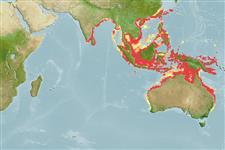>
Syngnathiformes (Pipefishes and seahorses) >
Syngnathidae (Pipefishes and seahorses) > Syngnathinae
Etymology: Hippocampus: Greek, ippos = horse + Greek,kampe = curvature (Ref. 45335).
More on author: Weber.
Environment: milieu / climate zone / depth range / distribution range
Ekologi
laut; payau berasosiasi dengan karang; nir-ruaya; kisaran kedalaman 10 - 80 m (Ref. 42735). Subtropical; 22°C - 27°C (Ref. 130605); 27°N - 36°S, 76°E - 155°E
Indo-Pacific: India and Sri Lanka to Australia; north to China.
Length at first maturity / Size / Weight / umur
Maturity: Lm 10.4 range ? - ? cm
Max length : 18.0 cm OT jantan/; (Ref. 48635); 13.6 cm OT (female)
deskripsi pendek
Kunci identifiaksi (pengenalan) | Morfologi | Morfometrik
Duri punggung (Keseluruhan (total)) : 0; duri punggung lunak (Keseluruhan (total)) : 16 - 20.
Found in the continental shelf, on muddy, sandy bottoms, rubbles and in coral reefs (Ref. 75154); in a sponge or seagrass habitat, often attached to hard and soft coral species (Ref. 128284). Ovoviviparous (Ref. 205). The male carries the eggs in a brood pouch which is found under the tail (Ref. 205). Maximum length is based on a straight-line length measurement from upper surface (ignoring spines) of first trunk ring, to tip of tail; female 13.8 cm (Ref. 42735). Less desirable for traditional Chinese medicine, but use may increase with the rise in patent medicines. Taken in trawls (Ref. 42735).
Male carries the eggs in a brood pouch (Ref. 205).
Lourie, S.A., R.A. Pollom and S.J. Foster, 2016. A global revision of the seahorses Hippocampus Rafinesque 1810 (Actinopterygii: Syngnathiformes): taxonomy and biogeography with recommendations for further research. Zootaxa 4146(1):1-66. (Ref. 115213)
Status IUCN Red List (Ref. 130435: Version 2024-1)
ancaman kepada manusia
Harmless
penggunaan manusia
Perikanan: komersial; Akuarium: Komersial
Alat, peralatan
laporan khas
muat turun XML
Sumber internet
Estimates based on models
Preferred temperature (Ref.
123201): 24.3 - 29.2, mean 28.3 °C (based on 992 cells).
Phylogenetic diversity index (Ref.
82804): PD
50 = 0.5000 [Uniqueness, from 0.5 = low to 2.0 = high].
Bayesian length-weight: a=0.00447 (0.00175 - 0.01142), b=2.99 (2.77 - 3.21), in cm total length, based on LWR estimates for this (Sub)family-body shape (Ref.
93245).
Trophic level (Ref.
69278): 3.4 ±0.5 se; based on size and trophs of closest relatives
Daya lenting (Ref.
120179): Tinggi, Waktu penggandaan populasi minimum kurang dari 15 bulan (tm=0.5-1).
Fishing Vulnerability (Ref.
59153): Low vulnerability (10 of 100).
Nutrients (Ref.
124155): Calcium = 66.6 [31.9, 177.6] mg/100g; Iron = 0.848 [0.431, 1.529] mg/100g; Protein = 18.9 [17.6, 20.0] %; Omega3 = 0.209 [0.109, 0.393] g/100g; Selenium = 18.3 [7.4, 43.1] μg/100g; VitaminA = 39.7 [10.8, 147.1] μg/100g; Zinc = 1.27 [0.77, 1.98] mg/100g (wet weight);
